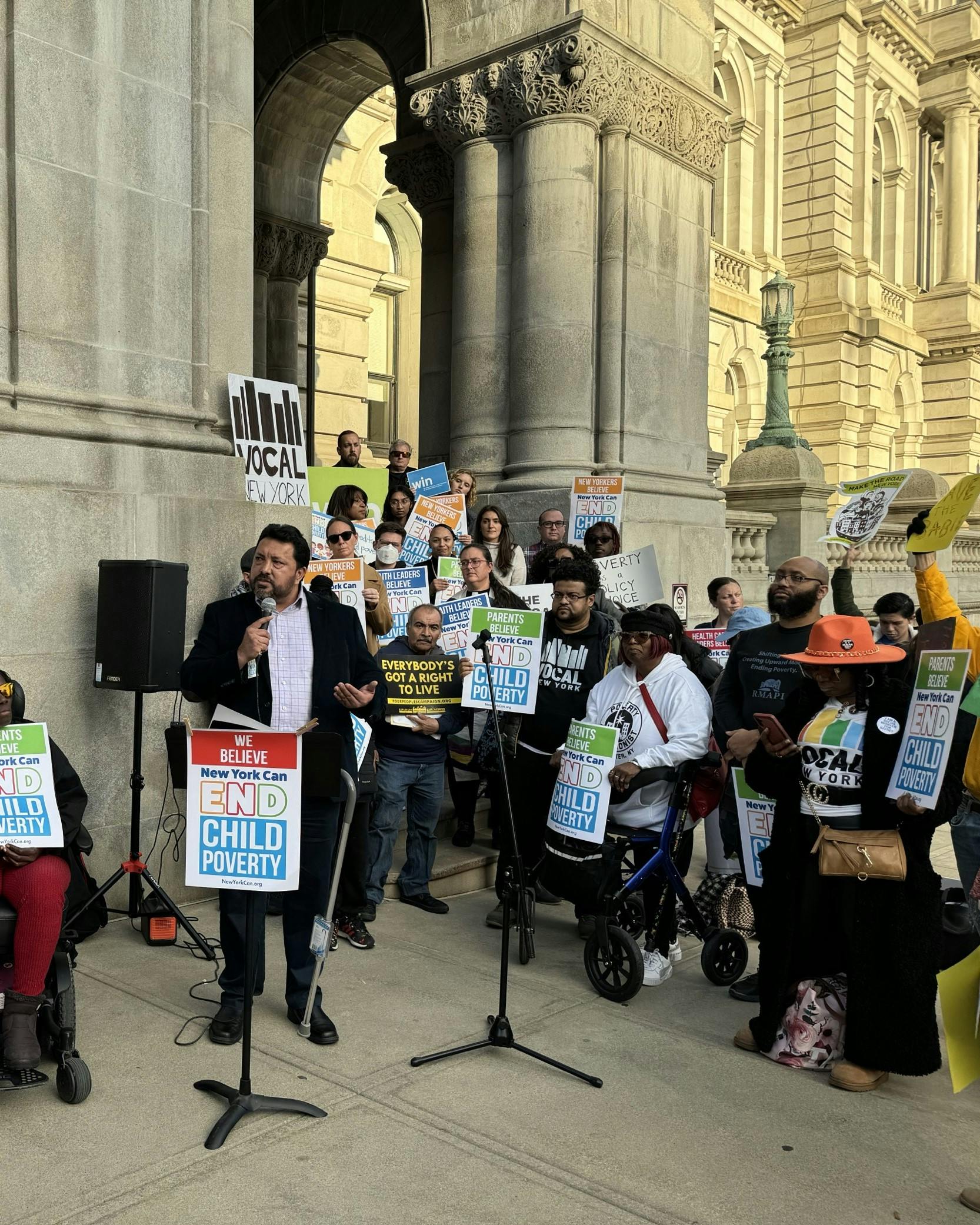

Ending Child Poverty in NY is Possible with Policy
Digital Briefs
November 25, 2024
By: Julie Kronick
In case you missed it, last week CCC joined parents, youth, legislators, health care providers, educators, and advocates as part of the New York Can End Child Poverty Coalition to rally for child poverty reduction efforts at the State Capitol in Albany. New York can and should be a leader in child poverty reduction. With one of the highest rates of child poverty in the country—1 in 5 children live in poverty—our state leaders have the responsibility to make investments that will create economic security for thousands of children and families—luckily, we have the solutions.
Three years ago, Governor Hochul signed the Child Poverty Reduction Act pledging to reduce child poverty by 50% by 2032. Since, a Child Poverty Reduction Advisory Council (CPRAC) was formed and has release data-backed recommendations for 2025 to reduce child poverty.
CCC is a member of the New York Can End Child Poverty coalition, a group of organizations from across New York State working to improve long-term outcomes for children and families in households experiencing economic hardship. The coalition’s work mirrors CPRAC’s in that it is focused on policies that will help the state meet its 50% child poverty reduction goal—except members agree that actions to reduce child poverty can be implemented and effective in much sooner than 10 years. Last month the coalition released its own packet of four poverty reducing recommendations that can be included in the state’s Fiscal Year 2026 budget and/or In upcoming legislative decisions.
What are these recommendations?
![]()
The following language is pulled directly from New York Can End Child Poverty’s one-pager reports.
- Refundable Tax Credits: Research shows that cash and near-cash benefits (such as tax credits) improve children’s health and educational outcomes, increase future earnings, and decrease costs in the realms of health care, child protection, and criminal justice. One of the most powerful refundable tax credits is the Child Tax Credit, officially named the Empire State Child Credit here in New York. Currently, NY’s child tax credit has a maximum of $330 per child annually. Increasing this to $1,500 would reduce child poverty by more than 23%. The state must also expand eligibility to the lowest-income families and index the tax credit to inflation.
- Housing Vouchers: Across New York State, nearly 2 in 5 (approximately 3 million) households are rent burdened, paying more than 30% of their income on housing, and 1 in 5 (approximately 1.5 million) are severely rent-burdened, spending more than 50% of their income on housing each year. New York should create its own rental assistance program to serve income-eligible renting households not currently receiving other rental vouchers. A statewide rental assistance program would cut child poverty by nearly 16% statewide. The program would move 82,000 children out of poverty.
- Cash Assistance: For many decades, New York State has provided cash assistance to low-income New Yorkers to fulfill basic cash needs (diapers, transportation, food, etc.), funded by local, State, and federal TANF (Temporary Assistance for Needy Families) funds known as the “Cash Assistance” program. However the amounts allotted to families have not been increased in 12 years and therefore do not truly support economic security. Additionally, rules about which working families qualify and how much they can save, leave many families out. The program needs a 100% increase in benefits to bring the level for a family of two to $500 per month. This would decrease child poverty by 18%. There are also other common sense reforms that would better affect child poverty reduction through cash assistance.
- Food Assistance for All: SNAP is a powerful tool for reducing child poverty, but across New York State, nearly 65,000 households with children are currently excluded from participating in SNAP due to their family’s immigration status. Creating a Food Assistance Program that fills in the gaps left by federal SNAP regulations would reduce child poverty and help make New York State’s ideals of racial equity and a welcoming home for all a reality. Plus, data shows that for every $1 in SNAP dollars, nearly $2 is invested back into the community.
Why does this work matter so much now?

New York has one of the largest economies in the world, but New York children are more likely to live in poverty than in 32 other states, amounting to a rate of roughly 1 in 5 children. The poverty rate approaches 1 in 3 among children of color and affects nearly half of children in some areas like Rochester, Buffalo, and Syracuse. In 2021 Governor Hochul and a supportive State Legislature signaled that poverty reduction is and should be a major priority for our state and we agree: the time to act is now.
Advocates, policymakers, and families have long understood the impact cash assistance and other supportive programs have on reducing child poverty, and this was further proven by data from pandemic-era emergency programming that significantly reduced child poverty nationwide. Specifically, data on the expanded child tax credit and the SNAP emergency allotments.
- An Urban Institute study estimated that the SNAP emergency allotments kept 4.2 million people above the poverty line in the last quarter of 2021, reducing child poverty by 14 percent.
- Census data showed that the temporary expansion of the Child Tax Credit (CTC) included in the American Rescue Plan led to a historic reduction in child poverty, lowering child poverty by more than 40%.
This data shows the true potential of the previous recommendations from poverty fighting organizations. Strong public policy that reduces child poverty not only makes good sense morally, but also makes sense for the future of our state because children are the future of New York. It’s time to invest in every child’s well-being; we can’t afford to wait. The return on investment for reducing child poverty is exponential and serves us all.




